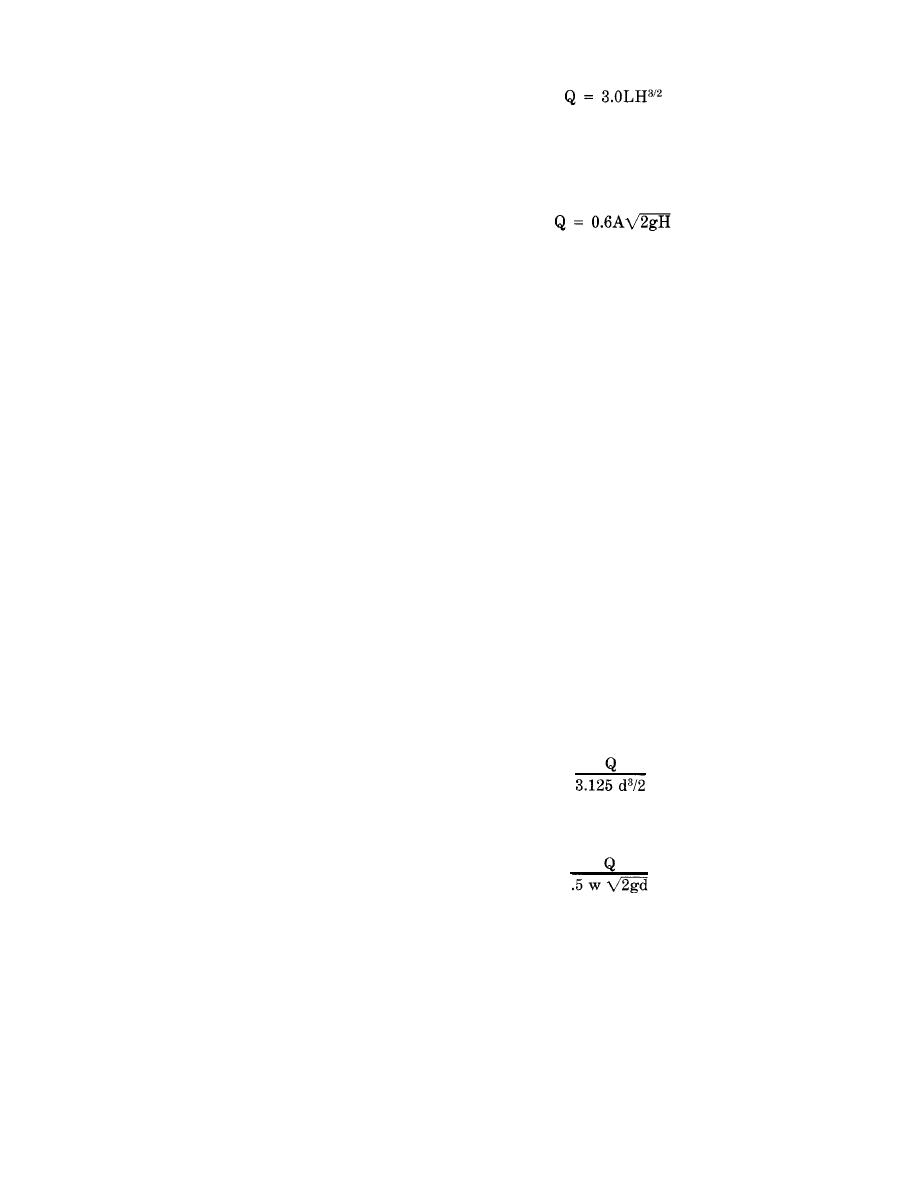
TM 5820-4/AFM 885, Chap 4
the several factors involved. The final selection of
the weir formula:
inlet types will be based on overall hydraulic per-
formance, safety requirements, and reasonable-
ness of cost for construction and maintenance.
If one side of a rectangular grate is against a curb,
this side must be omitted in computing the perim-
eter.
b. In placing inlets to give an optimum arrange-
(b) For depths of water above 1.4 feet use the
ment for flow interception, the following guides
orifice formula:
apply:
(1) At street intersections and crosswalks, in-
lets are usually placed on the upstream side. Gut-
(c) For depths between 0.4 and 1.4 feet, op-
ters to transport flow across streets or roadways
eration is indefinite due to vortices and other dis-
will not be used.
turbances. Capacity will be somewhere between
(2) At intermediate points on grades, the
those given by the preceding formulas.
greatest efficiency and economy commonly result
if either grated or curb inlets are designed to in-
(d) Problems involving the above criteria may
be solved graphically by use of figure 3-3.
tercept only about three-fourths of the flow.
(2) Curb Type (in sump). For a curb inlet in a
(3) In sag vertical curves, three inlets are often
sump, the above listed general concepts for weir
desirable, one at the low point and one on each
and orifice flow apply, the latter being in effect
side of the low point where the gutter grade is
for depths greater than about 1.4h (where h is the
about 0.2 foot above the low point. Such a layout
height of curb opening entrance). Figure 3-4 pre-
effectively reduces pond buildup and deposition of
sents a graphic method for estimating capacity.
sediment in the low area.
(3) Combination Type (in sump). For a com-
(4) Large quantities of surface runoff flowing
bination inlet in a sump no specific formulas are
toward main thoroughfares normally should be
given. Some increase in capacity over that pro-
intercepted before reaching them.
vided singly by either a grated opening or a curb
(5) At a bridge with curbed approaches, gutter
opening may be expected, and the curb opening
flow should be intercepted before it reaches the
will operate as a relief opening if the grate be-
bridge, particularly where freezing weather oc-
comes clogged by debris. In estimating the capac-
curs.
ity, the inlet will be treated as a simple grated
(6) Where a road pavement on a continuous
inlet, but a safety factor of 25 to 75 percent will
grade is warped in transitions between super-
be applied.
elevated and normal sections, surface water should
(4) Slotted drain type. For a slotted drain inlet
normally be intercepted upstream of the point
in a sump, the flow will enter the slot as either all
where the pavement cross slope begins to change,
orifice type or all weir type, depending on the depth
especially in areas where icing occurs.
of water at the edge of the slot. If the depth is less
(7) On roads where curbs are used, runoff from
than .18 feet, the length of slot required to inter-
cut slopes and from off-site areas should, wher-
cept total flow is equal to:
ever possible, be intercepted by ditches at the tops
of slopes or in swales along the shoulders and not
be allowed to flow onto the roadway. This practice
minimizes the amount of water to be intercepted
by gutter inlets and helps to prevent mud and
If the depth is greater than .18 feet, the length of
debris from being carried onto the pavement.
slot required to intercept total flow is equal to:
c. Inlets placed in sumps have a greater poten-
tial capacity than inlets on a slope because of the
possible submergence in the sump. Capacities of
d = depth of flow-inches
grated, curb, and combination inlets in sumps will
w = width of slot---.l46 feet
be computed as outlined below. To allow for block-
age by trash, the size of inlet opening selected for
d. Each of a series of inlets placed on a slope is
construction will be increased above the computed
usually, for optimum efficiency, designed to in-
size by 100 percent for grated inlets and 25 to 75
tercept somewhat less than the design gutter flow,
percent, depending on trash conditions, for curb
the remainder being passed to downstream inlets.
inlets and combination inlets.
The amount that must be intercepted is governed
(1) Grated type (in sump).
by whatever width and depth of bypassed flow can
(a) For depths of water up to 0.4 foot use
be tolerated from a traffic and safety viewpoint.
310



 Previous Page
Previous Page
